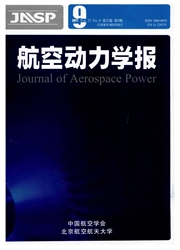

 中文摘要:
中文摘要:
研究了尾迹/激波相干对振动叶栅非定常流动的影响.数值方法利用了先进的谐波方法.该方法基于傅立叶变换,把叶栅非定常流变量分解为一时间平均量和若干谐波分量,继而,时域非定常N-S方程被转化为频域定常傅立叶系数方程.定常傅立叶系数方程的求解采用了伪时间推进方法.为加速数值解收敛,采用了本地时间步长和多重网格技术.通过NASA67转子算例结果表明:上游尾迹对振动叶栅非定常流动具有显著影响.当存在尾迹相干时,叶片通道内的激波在轴向方向上表现出较大的漂移运动,叶片所受的非定常力幅值变大,同时失去了时间周期性.
 英文摘要:
英文摘要:
This paper investigated numerically the influence of wake/shock interaction on the unsteady flow in oscillating blade rows. The numerical scheme chosen is an advanced harmonic method. Based on Fourier transform, turbomachinery unsteady flow variables can be decomposed into a time-averaged part and a number of harmonics identifiable by their frequencies. Thus, time-domain unsteady Navier-Stokes equations can be converted to frequency-domain steady Fourier coefficient equations. The solution of Fourier coefficient equations was obtained by using a conventional pseudo-time marching scheme. To speedup the solution convergence, local time stepping and multi-grid acceleration techniques were used. In this paper, the numerical method was used to study the unsteady flow response under wake and blade vibration interaction. The test case chosen was NASA67 Rotor oscillating a first torsion fashion. The results show an obvious influence of upstream wake on the unsteady flow in oscillating blade rows. In the presence of the upstream wake, shock in blade passages reveals considerable excursion in the axial direction and blades witness increased amplitude and temporal periodicity losing of the unsteady force.
 同期刊论文项目
同期刊论文项目
 同项目期刊论文
同项目期刊论文
 期刊信息
期刊信息
